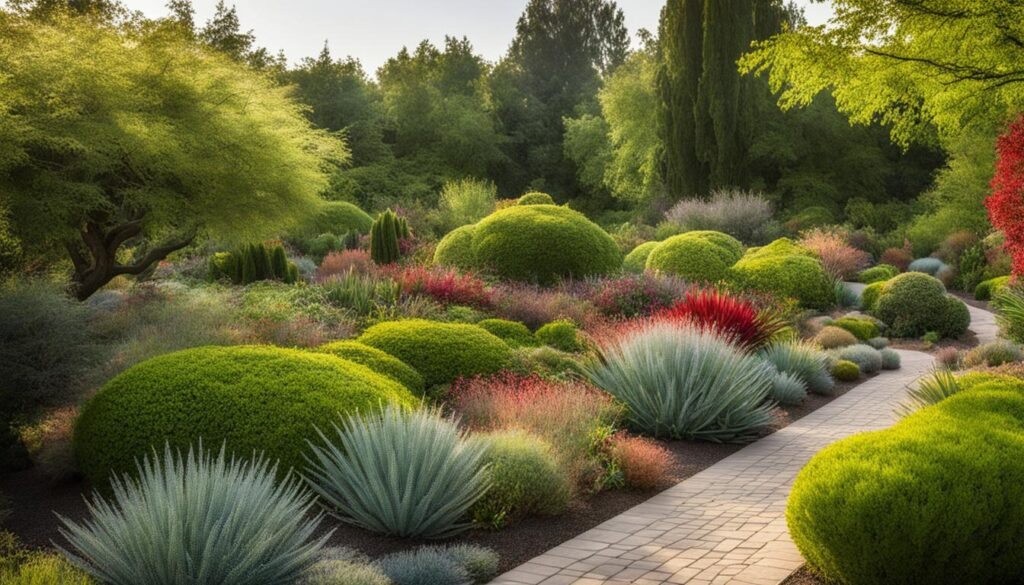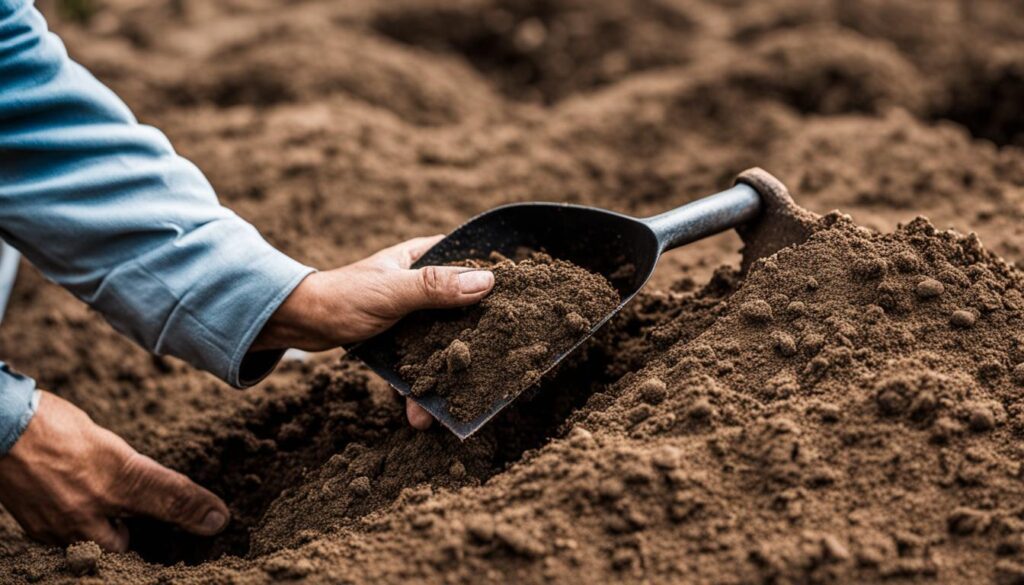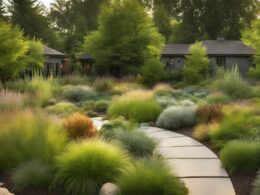Xeriscaping is a water-saving gardening technique that allows you to create a beautiful and sustainable garden. In this step-by-step guide, we will take you through the process of installing your own xeriscape garden. With the help of the information and resources provided, you’ll be able to create a garden that not only saves water but also adds beauty and interest to your outdoor space.
Key Takeaways:
- Create a xeriscape garden to save water and enjoy a visually appealing landscape.
- Select plants based on their water needs, light requirements, and maintenance requirements.
- Enhance your xeriscape garden with shrubs and trees that offer blossoms, fruits, and colors.
- Plan and design your xeriscape garden based on your needs, tastes, and practical considerations.
- Implement and maintain your xeriscape garden by removing grass, installing hardscape elements, and properly caring for xeric plants.
Understanding Perennial Gardening for a Three-Season Garden
To create a vibrant and ever-changing garden throughout the year, consider incorporating perennial plants into your landscape. Perennials are plants that live for more than two years, and they have the ability to bloom and provide interest for multiple seasons. By carefully selecting the right perennial varieties, you can ensure that your garden remains colorful and lush from spring through fall.
When choosing perennial plants for a three-season garden, it’s important to consider the specific conditions of your site. Factors such as soil type, sun exposure, and water needs play a crucial role in determining which plants will thrive in your garden. Native perennials are particularly well-suited to their local environments and often require less maintenance. On the other hand, non-native perennials can offer unique colors and textures that can enhance the overall aesthetic of your garden.
To make the selection process easier, consult plant lists and fact sheets that provide valuable information on water requirements, light conditions, and plant descriptions. These resources can help you narrow down your choices and ensure that you’re selecting plants that are well-suited to your specific gardening needs. Remember to consider the height, spread, and bloom time of each perennial variety to create a visually balanced and harmonious garden.
By understanding the principles of perennial gardening and carefully selecting the right plants, you can create a three-season garden that brings beauty and interest to your outdoor space year after year. Whether you prefer a cottage-style garden or a more contemporary design, the wide variety of perennial plants available ensures that you’ll find the perfect combination to suit your taste and create a garden that delights throughout the seasons.
Enhancing Your Landscape with Shrubs and Trees
Shrubs and trees are an excellent way to enhance the overall beauty and visual appeal of your landscape. With their vibrant blossoms and colorful foliage, these plants add a touch of natural elegance to any outdoor space. Whether you have a large yard or a small garden, incorporating shrubs and trees can create a stunning and picturesque landscape that will be the envy of your neighborhood.
When selecting shrubs and trees for your landscape, consider a mix of different varieties to add depth and texture. Some popular options include Serviceberry, Fremont mahonia, American plum, Buffaloberry, and Western sand cherry for shrubs, and European mountain ash, Pine, Colorado blue spruce, Aspen (Foothills and submontane areas only!), and Maple for trees. Each of these plants offers unique characteristics, such as colorful blossoms, bountiful fruits, and striking foliage, that will bring your landscape to life.
Choosing the Right Shrubs and Trees
- Consider the size and growth habit of each plant to ensure it fits well within your landscape and doesn’t overpower other elements.
- Take into account the specific conditions in your area, such as soil type, sun exposure, and climate, to choose plants that will thrive in your environment.
- Pay attention to the water requirements of each plant, as some may be more drought-tolerant while others require regular watering.
Before incorporating shrubs and trees into your landscape, it’s advisable to consult fact sheets and publications for detailed information on each plant’s requirements and characteristics. This will help you make informed decisions and ensure that the plants you choose are well-suited to your landscape.
By carefully selecting and incorporating shrubs and trees into your landscape, you can create a visually stunning and engaging outdoor space. These plants not only add bursts of color and visual interest, but they also provide shade, privacy, and habitat for wildlife. Whether you’re looking to create a serene garden or a vibrant and dynamic landscape, the right choice of shrubs and trees will elevate your outdoor space to new heights of beauty.
Planning and Designing Your Xeriscape Garden
Before embarking on your xeriscape garden project, it’s essential to plan and design your space to ensure a successful and visually appealing outcome. Consider how you use your yard and what design theme suits your taste and lifestyle. Are you envisioning a relaxing oasis, a vibrant flower garden, or a low-maintenance landscape?
Take practical considerations into account as well. Think about the practical needs of your outdoor space, such as wide pathways for easy navigation, storage areas, and clearance for trash carts. Also, consider if you need space for kids to play, outdoor dining or entertainment areas, or if you want to attract wildlife to your garden.
Remember, a well-designed xeriscape garden incorporates both aesthetics and function, providing a space that is not only visually pleasing but also practical for your needs.
In your design, you can incorporate existing plants and hardscape elements that complement your overall vision. Look for inspiration from public gardens, local plant societies, and resources like CSU (Colorado State University). These resources can provide valuable insight into plant selection, design ideas, and maintenance tips.
It’s important to be realistic about your time, skills, and budget when planning your xeriscape garden. Consider the level of maintenance your design requires and ensure it aligns with the time and effort you’re willing to invest. Additionally, be aware of any community regulations and seek necessary approvals before proceeding with your plan.
Key Points:
- Consider your design theme and practical needs when planning your xeriscape garden.
- Incorporate existing plants and hardscape elements that complement your vision.
- Seek inspiration and knowledge from public gardens, local plant societies, and resources like CSU.
- Be realistic about your time, skills, and budget.
- Check community regulations and obtain any necessary approvals.
How Does Soil Preparation Affect the Installation of a Xeriscape Garden?
Proper xeriscape garden soil preparation is essential for successful installation. Well-draining soil with added organic matter helps retain moisture, reducing water requirements. Breaking up compacted soil allows roots to penetrate easily, promoting healthier plant growth. Adequate soil preparation leads to a sustainable and thriving xeriscape garden.
Implementing and Maintaining Your Xeriscape Garden
Now that you have meticulously planned and designed your xeriscape garden, it’s time to put your vision into action and ensure its long-term maintenance. Implementing and maintaining your xeriscape garden requires careful steps and attention to detail. Here are some essential tips to help you bring your water-saving oasis to life and keep it thriving:
- Start with lawn conversion: To maximize water savings and reduce maintenance, consider removing your existing lawn. You can choose to remove the entire lawn at once or gradually convert it section by section. This process can be done effectively using the solarizing method or with the help of herbicides.
- Install hardscape elements: Incorporating hardscape elements such as pavers, gravel, or rocks not only adds visual interest to your xeriscape garden but also reduces the need for water and maintenance. Plan the placement of these elements strategically to create paths, seating areas, or focal points within your garden.
- Follow the order of installation: When planting your xeric plants, it’s important to follow the recommended order of installation. Start with the tallest plants in the back and gradually work your way forward. This ensures proper spacing and allows each plant to receive adequate sunlight and water.
- Maintain your xeriscape garden: While xeric plants require less water and maintenance compared to traditional landscapes, they still need care, especially during the establishment phase. Irrigate your plants regularly until they are well-established, and prevent weed growth by applying mulch or using landscape fabric.
Remember to familiarize yourself with any local regulations or homeowner association rules that may apply to your xeriscape garden. Obtain any necessary approvals before making significant changes to your landscape. If you’re unsure about any aspect of implementing or maintaining your xeriscape garden, don’t hesitate to seek professional guidance. With proper implementation and ongoing care, your xeriscape garden will continue to flourish and provide you with a beautiful and sustainable outdoor space to enjoy.
Expert Tip:
Consider incorporating a rainwater harvesting system into your xeriscape garden. Collecting rainwater allows you to supplement your plants’ watering needs without relying on treated tap water. It’s an eco-friendly solution that further reduces your water consumption and supports the sustainability of your garden.
Conclusion
Creating a xeriscape garden can be a fulfilling and rewarding DIY project. By following this step-by-step guide, you can transform your outdoor space into a beautiful, water-saving garden. With careful plant selection, practical considerations, and proper implementation and maintenance, you’ll be able to enjoy the benefits of a sustainable and visually appealing landscape.
Throughout your xeriscape garden journey, rely on research-based information to address any questions or issues that may arise. By staying informed and utilizing resources, you can ensure the success of your water-saving gardening endeavor.
Remember, the key to a successful DIY xeriscape project is to stay committed and dedicated to the maintenance of your garden. While xeric plants require less water and maintenance, they still need care, especially in the early stages. By putting in the effort, you’ll be able to enjoy a thriving and eco-friendly garden for years to come.
Start your water-saving gardening journey today and create a xeriscape garden that not only enhances the beauty of your outdoor space but also contributes to a sustainable future. Happy gardening!













